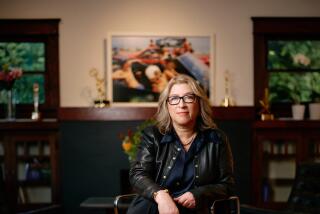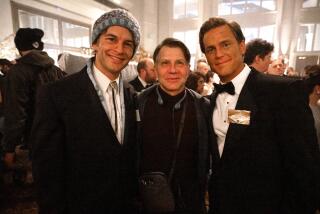Serious Comics : Teen-Agers Use Artful Approach to Warn Their Peers About AIDS and Perils of Unprotected Sex
Our tale begins on the planet Gython, inside the palace of the beautiful and civic-minded Princess Calyp.
“On the planet Earth there is a deadly disease called AIDS!” the dashing Captain Zynar reports.
“We must prevent that disease so it won’t happen here!” the princess replies.
The captain’s eyes drink in the princess’s pulchritude, and she returns his gaze. The little thought balloons above their heads erase any doubt about the mutual attraction.
Thus does love spark in an unusual comic book that largely reflects the vision of three Los Angeles teen-agers. To them Gython seems a happy kingdom, but the world of teen-age Earthlings is fraught with drugs, disease and heartache.
Such educational tools aren’t new in the campaign against AIDS, but this is believed to be the first AIDS comic book produced for mass distribution that was inspired by the notion that if young people won’t pay attention to adults, perhaps they’ll listen to each other.
“Like my parents think they understand what’s going on, but they don’t,” explained Becky Fierro, the 15-year-old creator of Princess Calyp and Captain Zynar. “I’d rather read something another kid wrote than an adult thinking they know what we’re going through.”
Young people “will relate to it at different levels. Not everybody goes to crack houses,” said 17-year-old Orlando Godoy, another of the authors.
The project was conceived by AIDS Project Los Angeles (APLA) with help from Barnsdall Art Center, a program operated by the city’s Department of Cultural Affairs. The teen-aged artists initially gave their comic book the working title “Killer Sex,” but “a couple of people are having a problem with that,” said Nicole Russo, a spokeswoman for APLA.
The double-entendre-- killer , in teenspeak, can translate as “very outstanding”--may not convey the proper message, some adults say. The proposed title, health workers suggested, could alienate adults who would be asked to distribute the comic book in schools, clinics, libraries and youth centers.
The new title is “Sex on Earth and Other Planets,” with the subtitle “Livin’ With HIV in the ‘90s.” Now nearing its final stages of production, the comic book is expected to be published later this month or in May with a first press run of 60,000 to 100,000 copies.
Health authorities agree that more needs to be done to educate teens and preteens about the risk of human immunodeficiency virus (HIV). A national study conducted in 1990 by the Centers for Disease Control found that 54% of high school teen-agers had had sexual intercourse at least once, and only 45% of those teen-agers had used a condom in their last sexual encounter.
Among the 14,371 AIDS cases reported in Los Angeles County as of Jan. 31, about 2,500 were people younger than 29. Because the incubation period between an HIV infection and a case of AIDS can be as long as 10 years, “a lot of them must have been infected when they were teen-agers. We just don’t know how many,” said John Schunhoff, assistant director of AIDS programs for the county Department of Health Services.
Lori Wolfe, a social worker who works in the HIV program at Childrens Hospital of Los Angeles, said it was “wonderful” that teen-agers were creating the comic book.
At a recent Washington conference on adolescent health care, Wolfe said, there was wide agreement that young people are often the best educators.
“Youth have more impact on their peers than adults going in and telling them what to do and not to do. . . . And youth are more likely to open up to their peers to ask questions,” Wolfe said.
Using an education grant from the city’s Community Development Department, APLA is spending about $10,000 on the project. A major comic book publisher is providing technical assistance and doing the printing at a reduced cost.
Russo declined to identify the firm, saying the company requested anonymity because of concerns that an association with the AIDS issue could alienate their traditional “middle America” audience. “They’re afraid it would have a negative impact on their company,” she said.
The comic book deals not only with AIDS, but the issues of drug abuse and teen-age sexuality. It reads as a grim but ultimately hopeful tale that reflects Fierro’s buoyant affection for science fiction, Godoy’s sensitivity to real-life teen-age drama and 15-year-old Daniel Carnow’s dark slant on avenging super heroes.
Fierro, Godoy and Carnow are members of a small class of art students brought together in January to produce the project under the guidance of Barnsdall art instructor Susan Weller and APLA health educator Linda Preciado. They wrote and illustrated three stories that were merged into a single narrative with the help of some Gython stealth technology.
Niquan--another Fierro creation--is an invisible, computerized eye that is sent from Gython to Earth to study AIDS. (Later we learn the AIDS virus has somehow made a toehold in Gython, brought there by intergalactic space travelers, one presumes.)
Niquan’s mission begins with a stop at what Godoy calls “a typical, all-American, teen-age party,” where it witnesses the interaction of a closeted gay youth named Nick and his straight, sexually active friend Julio. Here we also meet a doomed drug abuser named Jennie.
Later, Niquan follows Jennie to a crack house. Here the evil drug dealers are suddenly confronted by a dynamic duo of anti-drug vigilantes called Shadow Blade and Rachel Roberts--both created by Carnow. They violently dispatch the bad guys and give Jennie a stern lecture about the dangers of drug addiction.
But it’s too late for Jennie; she has already been infected with HIV. Her death is reported in a later scene, and Julio is devastated to discover that he is infected, apparently via his single unprotected tryst with Jennie.
Julio turns to his friend Nick to help him through the crisis. Nick “basically tries to tell him there is life after HIV,” Godoy said. And when Nick confides to Julio that he is gay, their friendship remains strong.
“They basically help each other,” said Godoy. One of the morals of the story, he said, “is that it’s OK to be who you really are.”
Meanwhile, back on Gython, the romance of Captain Zynar and Princess Calyp has been blossoming.
Soon our heroes are addressing the Gython people about the merits of abstinence, monogamy and “safer sex” through the use of condoms in preventing the spread of the AIDS virus.
And by all appearances, the people of Gython, if not the people of Earth, live happily ever after.
More to Read
The biggest entertainment stories
Get our big stories about Hollywood, film, television, music, arts, culture and more right in your inbox as soon as they publish.
You may occasionally receive promotional content from the Los Angeles Times.










